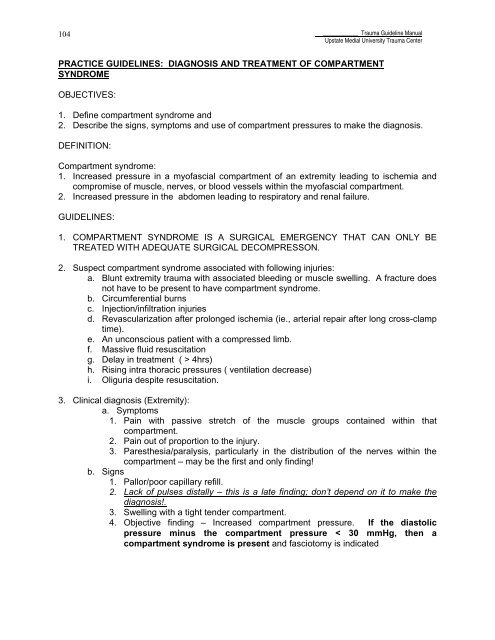Trauma Guideline Manual - SUNY Upstate Medical University
Trauma Guideline Manual - SUNY Upstate Medical University
Trauma Guideline Manual - SUNY Upstate Medical University
Create successful ePaper yourself
Turn your PDF publications into a flip-book with our unique Google optimized e-Paper software.
104____________ <strong>Trauma</strong> <strong>Guideline</strong> <strong>Manual</strong><strong>Upstate</strong> Medial <strong>University</strong> <strong>Trauma</strong> CenterPRACTICE GUIDELINES: DIAGNOSIS AND TREATMENT OF COMPARTMENTSYNDROMEOBJECTIVES:1. Define compartment syndrome and2. Describe the signs, symptoms and use of compartment pressures to make the diagnosis.DEFINITION:Compartment syndrome:1. Increased pressure in a myofascial compartment of an extremity leading to ischemia andcompromise of muscle, nerves, or blood vessels within the myofascial compartment.2. Increased pressure in the abdomen leading to respiratory and renal failure.GUIDELINES:1. COMPARTMENT SYNDROME IS A SURGICAL EMERGENCY THAT CAN ONLY BETREATED WITH ADEQUATE SURGICAL DECOMPRESSON.2. Suspect compartment syndrome associated with following injuries:a. Blunt extremity trauma with associated bleeding or muscle swelling. A fracture doesnot have to be present to have compartment syndrome.b. Circumferential burnsc. Injection/infiltration injuriesd. Revascularization after prolonged ischemia (ie., arterial repair after long cross-clamptime).e. An unconscious patient with a compressed limb.f. Massive fluid resuscitationg. Delay in treatment ( > 4hrs)h. Rising intra thoracic pressures ( ventilation decrease)i. Oliguria despite resuscitation.3. Clinical diagnosis (Extremity):a. Symptoms1. Pain with passive stretch of the muscle groups contained within thatcompartment.2. Pain out of proportion to the injury.3. Paresthesia/paralysis, particularly in the distribution of the nerves within thecompartment – may be the first and only finding!b. Signs1. Pallor/poor capillary refill.2. Lack of pulses distally – this is a late finding; don’t depend on it to make thediagnosis!.3. Swelling with a tight tender compartment.4. Objective finding – Increased compartment pressure. If the diastolicpressure minus the compartment pressure < 30 mmHg, then acompartment syndrome is present and fasciotomy is indicated
















